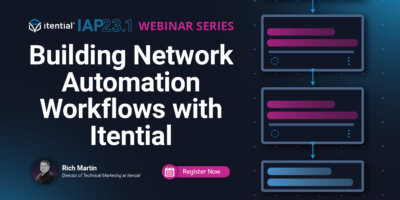Getting started with automating network infrastructure requires a logical, step-by-step approach. You should start simple with a relevant use case and translate the process into a series of logical tasks. Then, you can build out integrations and surrounding processes to ensure it works with your infrastructure and meets your standards. Last, you will implement your tasks until the workflow is complete.
In the first part of the demo series on Building Network Automation Workflows with Itentiall, we “start simple” by identifying a common networking use case and leveraging Itential’s low-code, visual canvas to build a workflow that supports that use case. We define the logical steps of the workflow using “stub” tasks as placeholders, and then eventually replace those temporary stub tasks with active tasks to create an automation that’s ready to deploy.
In this demo, Rich Martin, Director of Technical Marketing at Itential, shows you step-by-step how to:
- Stub out an initial workflow for a simple network automation.
- Choose and configure tasks for CLI or API network solutions.
- Generate and validate input for the workflow via a form.
- Format and translate data between tasks using Data Transformations.
- Run and test the workflow as part of the building process.
